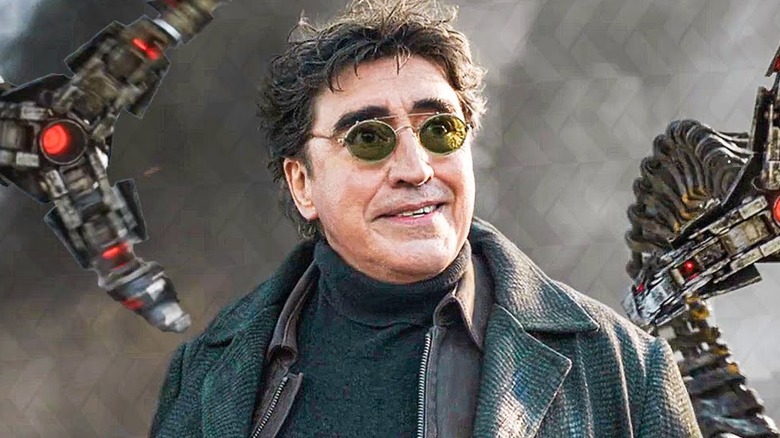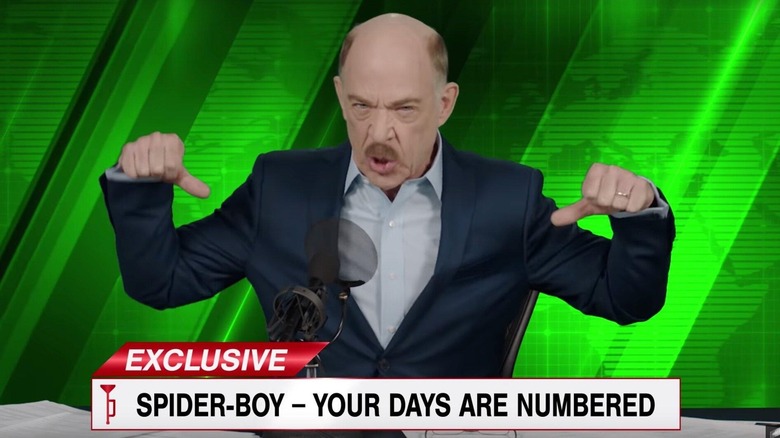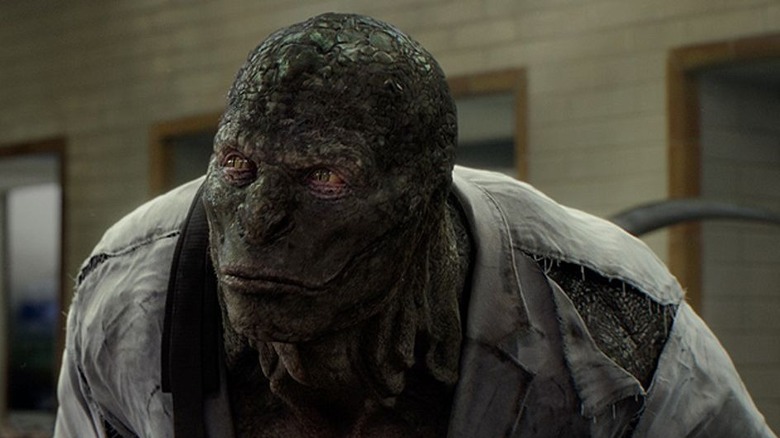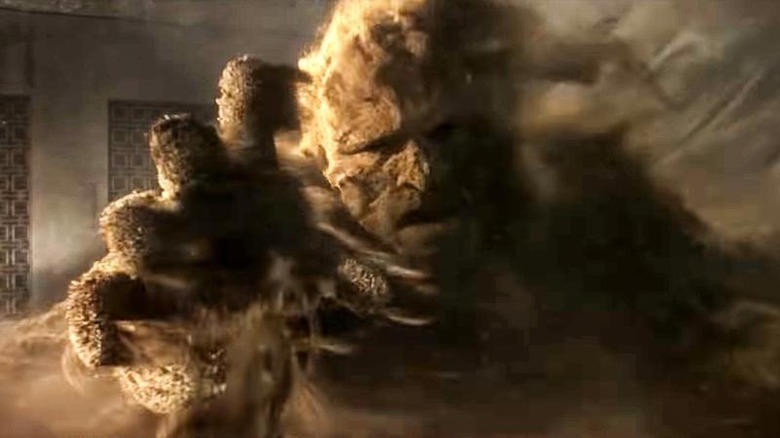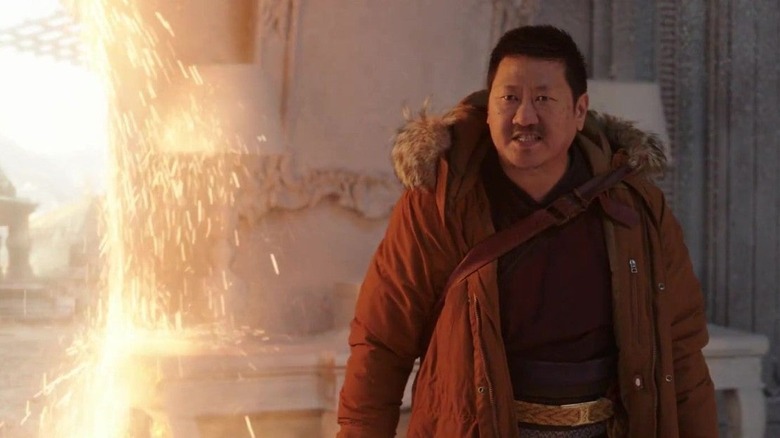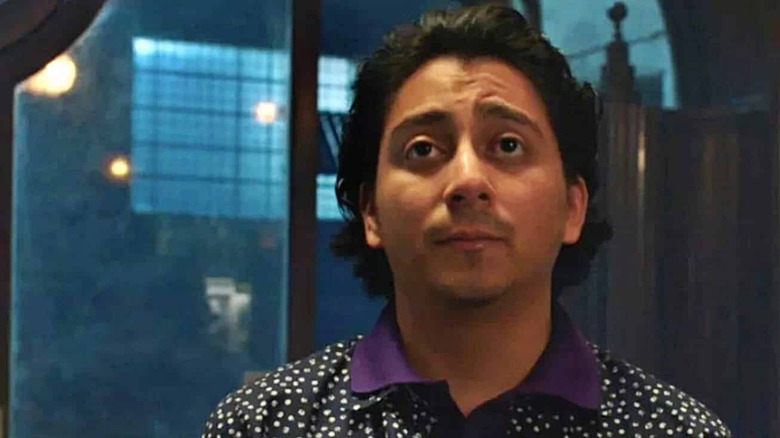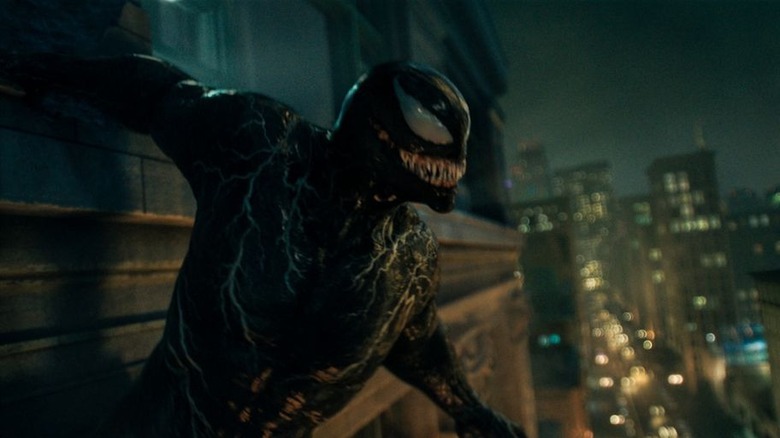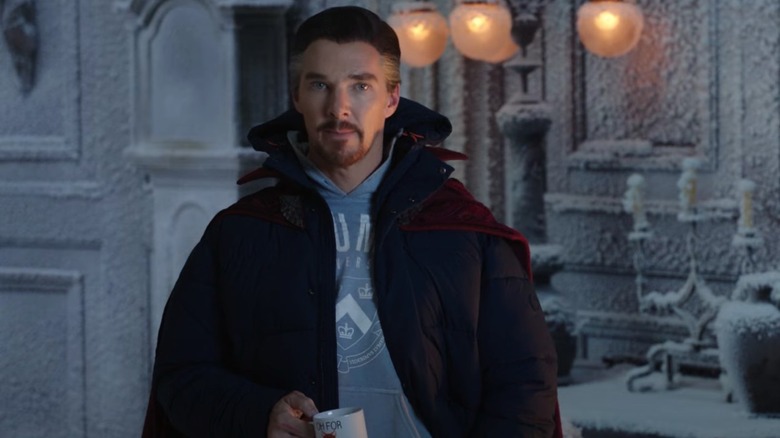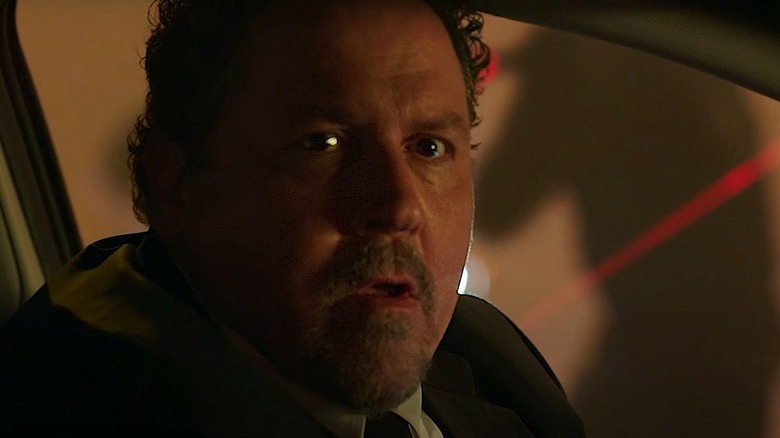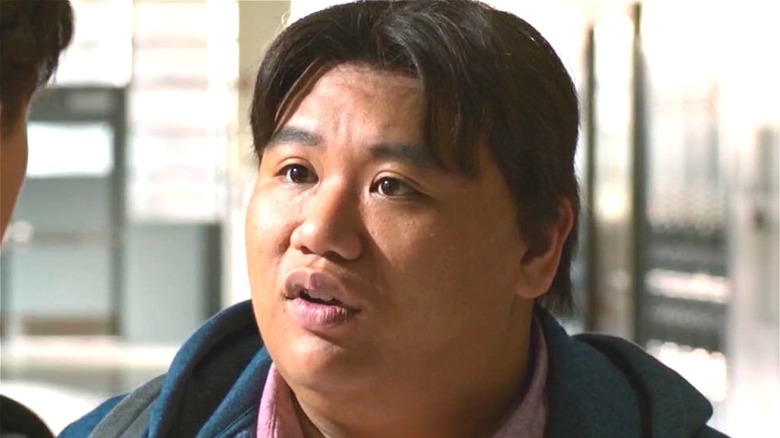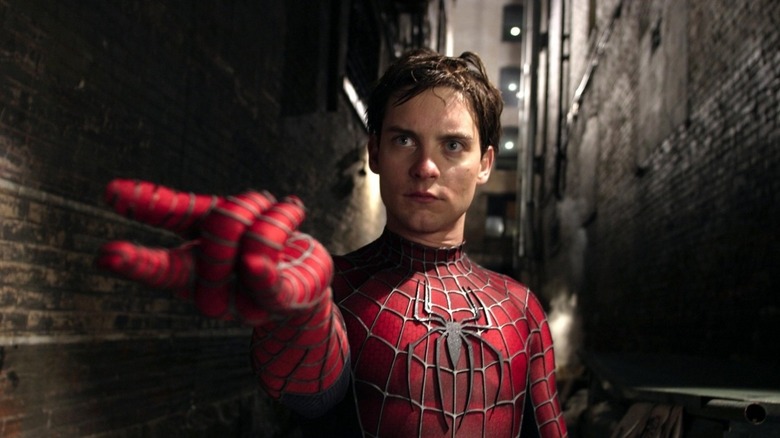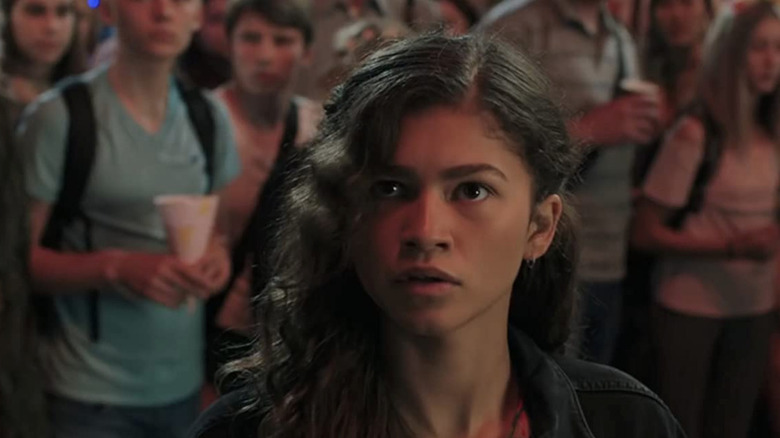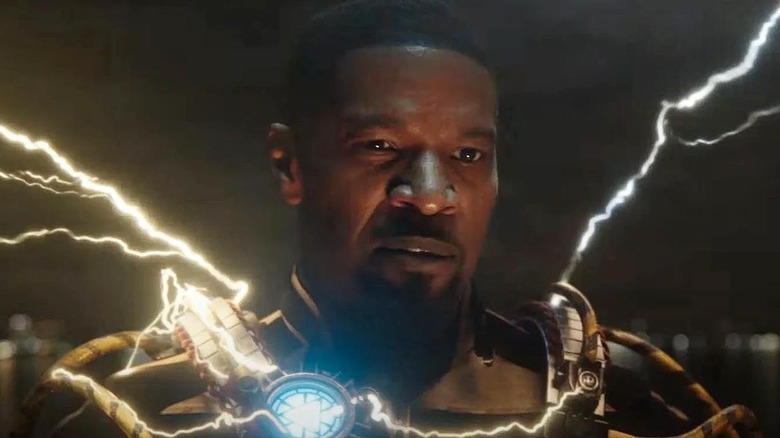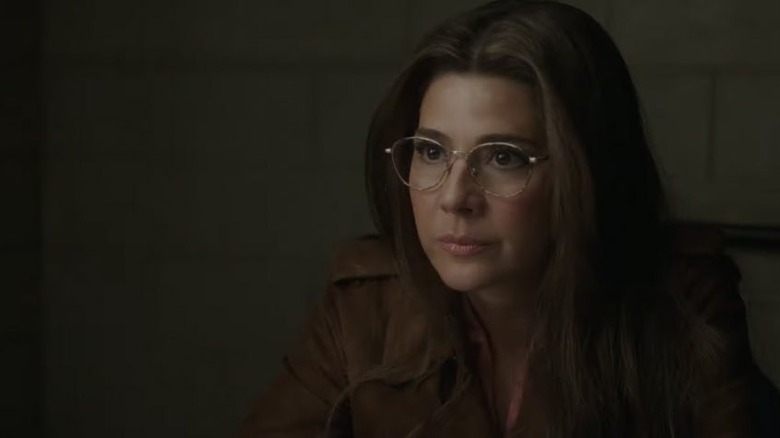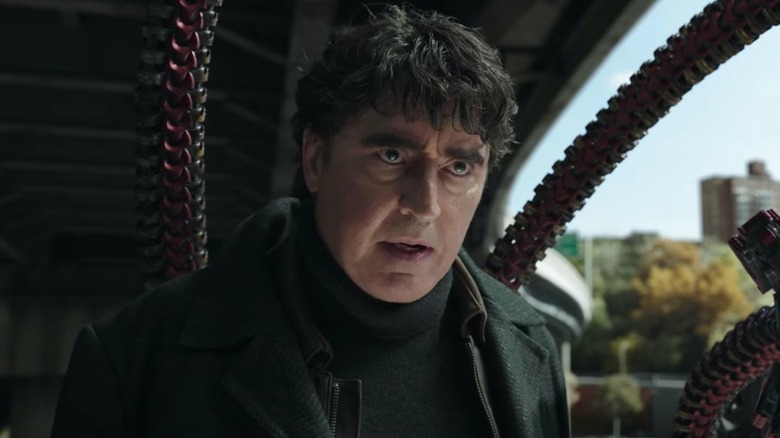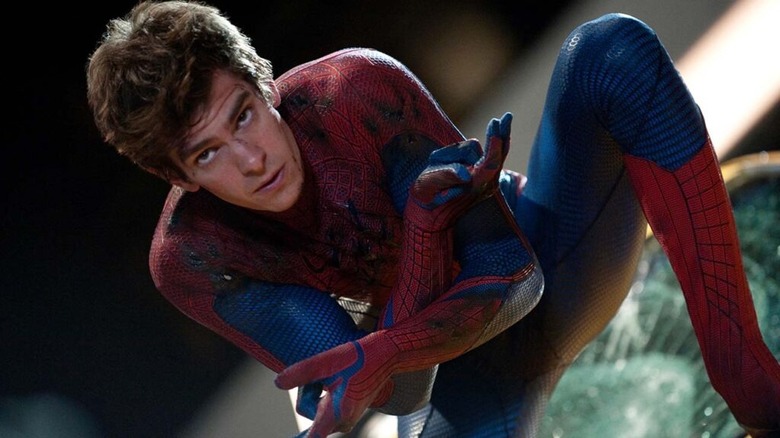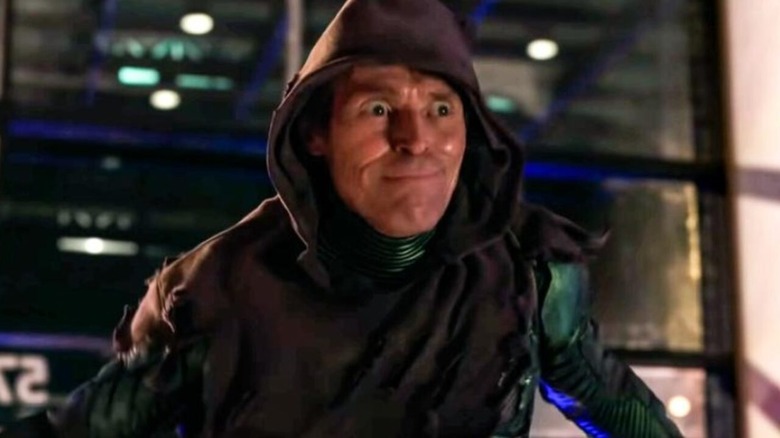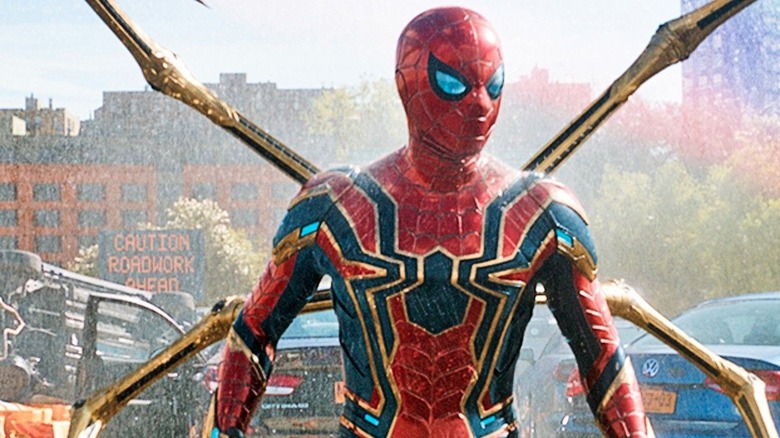The Best Characters In Spider-Man: No Way Home, Ranked
At its core, fan service is material that's been added to a film for an audience's pleasure. Usually, it's not relevant to the story. It does not care for your "Save The Cat!" beat sheet or Robert McKee's three-act structure. Even at its best, it's extraneous. I was so worried that Jon Watts' "Spider-Man: No Way Home" was going to be "Fan Service: The Movie." I am thrilled to report that it isn't.
Yes, there are meta-textual gags about Tobey Maguire's back and Paul Giamatti's Rhino in "Spider-Man: No Way Home." But, more often than not, Watts' film is in conversation with the movies that preceded it, not blindly worshipping them. That leads to character beats that redeem misguided moments from the Spider-Man films of the past. It makes plenty of room for the characters who already exist in MCU's continuity. And, ultimately, it all adds up to a film that gives the fans exactly what they think they want, even when it's sneakily doing the polar opposite. "Spider-Man: No Way Home" is a movie full of sterling, fascinating characters, mostly rendered with an exquisite attention to detail. Here are the best characters from "Spider-Man: No Way Home," ranked.
17. J. Jonah Jameson
J. Jonah Jameson is ostensibly Alex Jones in "Spider-Man: No Way Home" and, in the parlance of an infamous meme, he always has been. Jameson is a hack. His cowardice yields cheapness and cut corners. There is nothing Jameson won't do or say to force a story into the shape he desires. In "No Way Home," that is his one defining factor. It's as solid as the green screen he pontificates in front of.
The problem? That's all there is.
I am thrilled with "Spider-Man: No Way Home." But I was also thrilled for a film in which J. Jonah Jameson was going to serve as a credible threat to the ol' webhead, not merely the catalyst for multiversal madness. Many other villains from Raimi and Webb's Spider-Man films get their due here. Not so with J. Jonah. He is who he's always been: a hack, more one-dimensional than ever.
16. The Lizard
During the climactic battle at the end of "No Way Home," Rhys Ifans' Lizard screams "I told you there'd be consequences!" He's referring to Peter Parker's decision-making, but the Lizard might as well be calling out his much-maligned role in 2012's "The Amazing Spider-Man." Simply put, it's why he stinks here.
It's not that the Lizard, aka Dr. Curt Connors, isn't a compelling character — if anything, he's a Universal movie monster in a comic-book universe. Take the Wolfman, and make him an academic. The problem is that, in "No Way Home," Connors isn't Dr. Otto Octavius. There's only room for one paternal professor in the film's extensive rogue's gallery, and while reducing the Lizard to a poorly dressed CGI Koopa Troopa gives Doc Ock a larger spotlight, it makes the Lizard himself a stooge.
Is that unfortunate? Yes, it is. But getting reduced to a bit-player is a consequence of "No Way Home" embracing the full, multi-studio multiverse — ironically, the very thing that Connors warned us about.
15. The Sandman
As I wrote in an earlier article for /Film, the Sandman is the broken heart of "Spider-Man 3," a man whose happiness has been slipping like, well, sand through his fingers for far too long. Realized almost entirely through ghoulish CGI, Thomas Haden Church's distrusting heavy is a character who speaks about the pathos of his situation, but never gets a chance to really show it. We are meant to feel for a man-shaped tower of sand whose aesthetic belongs on a Sega Dreamcast. Simply put, it doesn't work — or rather, it works in service of other, more important characters, but doesn't allow Sandman to stand on his own two feet.
As with the Lizard, having some villains take a backseat is vital to balance out the larger film. But James Badge Dale's Coldblood was a backseat passenger in "Iron Man 3" and quietly emerged as one of the MCU's most memorable bad guys. Elizabeth Debicki's Ayesha has minimal screen time in "Guardians of the Galaxy Vol. 2," but audiences leave James Gunn's movie wishing to know more about her. In "No Way Home," Flint Marco doesn't rise above the role he has in this specific film, which is mostly an uninteresting one.
14. Wong
There are no small parts, only small actors. We know this. It's an idiom that's been burnt into the audience's brain since Konstantin Stanislavski uttered it more than 100 years ago, a maxim that celebrates the ensemble and encourages us to watch it with hawk-like focus. As such, Benedict Wong's magician's 90 seconds of screen time is an act of character extension. With a single line in the film's first act, Wong shows us who he truly is.
"Just leave me out of this." That's what Wong utters before using a portal to hop past Dr. Strange and Spider-Man, removing himself from their dangerous business. Wong is the new Sorcerer Supreme, a man who stands as Earth's first line of defense against magical and mystical threats. Both Strange and Spider-Man fall under his purview. Wong is also empathetic, mischievous, and the victim of a previous memory wipe. With six words and one action, we learn more about this minor character's worldview than we do for the protagonists in many less ambitious movies.
Between his minor appearances here and "Shang-Chi," Wong represents the one of the richest paths forward for Marvel's supporting players, one that rewards repeat appearances and progresses their arcs with each subsequent chapter. No small parts, indeed.
13. Flash Thompson
Flash Thompson is the tech-bro Peter Parker could've been in a different life. His hero worship is enhanced by his endless resources. An extravagant Audi? Not an issue for Flash (or Tony Stark). Irrationally confident TikToks? As easy as Cap throwing his shield. Flash builds his entire personality out of how he is perceived, as if his legitimate intelligence is a perk of his massive privilege.
In "No Way Home," we see that Flash is unable to perceive himself. Confronted with the truth that Peter Parker is Spider-Man, Flash collapses in spite of the walls he's built around his sheltered existence. We see the cracks form in a terrific early one-shot. We watch him struggle to fix them as Peter extricates much needed info from Flash at an MIT mixer. Flash is now the person he might have been if he'd ever been humbled by life, a guy whose future is still on a silver platter, but who looks less emotionally certain than ever. Maybe Peter, in his own way, also saved Flash, too.
12. Eddie Brock and Venom
while back, I explained how comedy is "the Rosetta Stone that explains the Venom films," nothing that they "cultivate a gloriously dumb comedic streak that combines slapstick with jokes about using bad guys' heads as bowling balls." I wondered if that sophomoric bent would make the leap to the MCU alongside Eddie Brock.
Thank God, it did. Venom's biggest impact on "No Way Home" is leaving a piece of himself behind, which will no doubt cause trouble for Peter Parker in future MCU movies, but it's his minor contributions that leave a lasting impression — namely, getting wasted while talking to Danny Rojas about the Avengers.
Again, so dumb! But gloriously so. One of Phase 4's sneakiest improvements to the MCU is how it embraces more character-specific strains of comedy. Marvel's films and TV shows have evolved past "quippy" as a de facto sense of humor. There's Awkwafina's absurdism in "Shang-Chi." Kate Bishop gets to be brazenly deadpan in "Hawkeye." And here, for a brief time, is the very strange kind of stupid that Tom Hardy has turned into an artful, strangely pleasing calling card. Thank goodness.
11. Doctor Strange
Doctor Strange is an emotional McGuffin in "No Way Home," a character who exists mostly to set the plot in motion and, more importantly, help disguise the film's true emotional center, May Parker. Strange is the latest powerful (and often goateed) man that Tom Holland's Peter Parker has run to for help, coming on the heels of Mysterio and Nick Fury in "Far From Home," and Tony Stark before them. In its first trailers, that decision gave "No Way Home" the uneasy scent of something that feels too familiar. Some assumed that Doctor Strange was Mysterio in disguise. Others made light of his Tony-like appearance. In either case, it didn't feel quite right.
I am both thrilled and heartbroken to report that, no, it wasn't right at all.
Peter Parker's story is, sadly, one of taking a loved one for granted and building a life out of the shattering consequences of that flaw. In most iterations, that's Peter's Uncle Ben. In the MCU, it's Marisa Tomei's Aunt May. It's a choice that retroactively improves "Homecoming" and "Far From Home." Peter, it seems, has been searching for his next Uncle Ben over three separate movies. He didn't realize that she was right in front of him until it was much too late. As a character, Strange serves as a fantastic distraction, and has no shortage of sarcastic charm. But it's the fact he's merely a red herring that lingers in the mind long after "No Way Home" has ended.
10. Happy Hogan
I have a feeling that Happy Hogan is a dog person. "No Way Home" offers ample evidence. He takes in strays, including the Parkers. He is almost dog-like himself, from the never-ending loyalty he has for Aunt May and Peter Parker, even as the Parkers end up laying a literal siege to his condo. Both Happy's endless capacity to provide and the way he wears his heart on sleeve in "No Way Home" offer a stirring referendum on a character who has graced the MCU since its inception, a connective tissue who, time and time again, has reminded us that heroes are loyal to doing what is right against all odds.
It's a journey that comes full circle in the crushing epilogue of "No Way Home," when he and Peter both wind up at Aunt May's grave. In that moment, what becomes abundantly clear is just how many loved ones both men have buried. For Peter, death becomes a catalyst for action, but Happy's fate is more unknown than ever. Happy has offered love to some truly great people, and all of them are gone. And yet, he looks ready to carry on against those crushing odds. "No Way Home" reveals the breadth of Happy Hogan's heart. At the very least, I hope he gets a dog to ease his pain.
9. Ned
Many of the best moments in "Spider-Man: No Way Home" concern identity. Most of those involve the various Peters, but others, no less crucially, concern Peter's best friend, Ned. Ned sees himself as "the guy in the chair." When Ned gets played like a fiddle during an early interrogation scene in "No Way Home," it's because his self-forged identity as Spidey's right-hand man is a massive point of pride, the power-up that lets Ned fight by Peter's side, not in his shadow.
Like most identities, however, the "guy in a chair" is just a construct. One of the things that's gorgeous about "No Way Home" is how often it goes out of its way to show us that Ned is, as it turns out, magic. He winds up summoning not one but two Spider-Men into his grandmother's kitchen. Later, he opens a portal that brings Doctor Strange to the showdown on the Statue of Liberty. Ned isn't really the "guy in the chair." He's Peter's secret weapon. And when Ned, along with MJ, holds Peter in the wake of May's passing, his capacity for love is fully revealed. We knew that Ned was fun prior to "No Way Home," but in its wake his identity can be better summed up in one word: vital.
8. Peter Parker (Tobey Maguire)
There's no shortage of moments that feel designed to make long-time Spider-Man fans cry in "No Way Home." Chief among them, though, is an interlude between Doctor Otto Octavius and Tobey Maguire's Peter Parker (aka "Peter 2"). Otto, seeing his Peter for the first time since all this wildness started, asks him plainly, "How are you?" Peter responds, "Trying to do better."
Yes, that's a nod to "Spider-Man 2," in which Otto called Peter "brilliant but lazy," but it also encapsulates the disarming sincerity that made us believe in Maguire's Peter Parker in the first place. More than any other actor who's donned the Spider-Man mantle, Maguire embodies unforced optimism. That's the undercurrent of his career-best work in "Seabiscuit," and it anchors Gary Ross' "Pleasantville." Even during the darkest moments of "Spider-Man" and "Spider-Man 2," Maguire never loses his wide-eyed enthusiasm.
This is why he's wonderful in "Spider-Man: No Way Home." Of the three Spider-Men, Maguire's Peter has the least material to chew on, but the quiet hope that he exudes infuses the whole movie — just look at the way he grins when he admits that he's "been stabbed a lot." Maguire's Peter viscerally reminds us why many of us learned to love Peter Parker in the first place. That's worth shedding a tear over.
7. MJ
There's a throwaway moment in "No Way Home" that I can't stop thinking about. While being held for questioning, MJ is referred to as Michelle Jones-Watson. Without missing a beat, MJ issues a correction: "Just MJ. No Watson." You could argue that this is fan service, an Easter egg that confirms that Zendaya's character is a spin on comic book canon. I say that it means more than that.
In both the comics and the Sam Raimi films, Mary Jane is born to an abusive, alcoholic father, Phillip Watson. She's not just acting aloof for cred. She's walled off her heart to protect herself from danger. In "Spider-Man," Peter overhears her father's violence and comforts MJ after an exchange that makes her flee her home. Ostensibly, he comes to her rescue. By contrast, "No Way Home" implies that Zendaya's MJ has already rescued herself. Just MJ. No Watson.
This is the triumph of the Watts trilogy's MJ. She's a character whose depths are often easy to miss in the wake of Zendaya's effortless charm. In "No Way Home," MJ is a devoted partner. She's a kind friend. She's occasionally the funniest person on screen, and a genuine threat to Spidey's rogue's gallery. She doesn't need Peter. She can just be MJ. But that knowledge is why the film's third act strikes viewers like a brick sack. I'm guessing that you can't stop thinking about it either.
6. Electro
Speaking of tiny, memorable exchanges, in the third act of "No Way Home," Andrew Garfield's Peter shares a quiet moment with Max "Electro" Dillon after curing him of his powers. Dillon admits that he thought Spider-Man was Black, and how that made him feel seen. Peter claims that Max wasn't invisible. Max's instantaneous, non-histrionic response? "Yes, I was." Just like that, the character I dubbed the worst live-action Spider-Man villain becomes one of the franchise's most compelling.
"Spider-Man: No Way Home" is something of an "Amazing Spider-Man 2" reclamation project. It honors the legacy of Marc Webb's movie more than once. Occasionally, it redefines it. In the case of Jamie Foxx's Electro, the film cuts through its predecessor's maddening aesthetic choices to arrive at the heart of what makes Max Dillon compelling. Max is a man who society has rendered invisible. In Spider-Man, Max saw a person of color with power that was out of his grasp, even as an electrical engineer for the country's most powerful corporation. In Spider-Man, Max sees that anyone can wear the mask. Max Dillon was invisible. But now, as an audience, we finally see him clearly.
5. Aunt May
For audience members who know Spider-Man primarily through the movies, Aunt May has always been there. She's been played by three sterling actresses, each with their own unique spin on the role. Her influence has been steadfast, and her affection equally so. There are so many good May moments across the Spider-Man movies that it's hard to pick a favorite, but the one-two punch of Rosemary Harris kicking Joel McHale's bank teller in "Spider-Man 2" and Sally Field crying buckets when she tells Peter that he's her boy in "The Amazing Spider-Man 2" should prove that May is, and always has been, a knockout character.
But, as of "No Way Home," the most memorable moment of Aunt May's onscreen career now belongs to Marissa Tomei.
No, it's not her death. It's how she races to keep Peter alive. It's not Peter's face when Aunt May passes. It's how clearly Aunt May's parting words make both him and the audience realize that she has been an advocate for the balance between power and responsibility since we first met Tomei's version of the character in 2017. We, like Peter, have both loved May and taken her for granted. In that gorgeous, horrifying, heartbreaking death scene, we catch up to who Aunt May really is. She has always been there. Now she isn't, and the size of that loss reveals the inimitable strength of her character.
4. Doctor Octopus
It can be difficult to separate the performance from the character, so let me rip the band-aid right off and say that Alfred Molina owns in "Spider-Man: No Way Home." Molina marries the baroque eloquence of his 2004 performance to 2021's quiptastic voyage. He transcends elaborate (and effective!) CG de-aging. He's absolutely incredible.
But he wouldn't be so incredible if "No Way Home" didn't give him cause to be.
Doctor Octopus is Exhibit A of the film's eventual thesis, that there is never a reason to give up on doing the right thing, even if it demands immeasurable sacrifice. Otto is lost, trapped within the landscape of a brain-corrupting inhibitor chip. Peter Parker finds him and returns him to his best self, despite resistance from a wizard. And when Doc Ock becomes Otto Octavius again, we are treated to the warmth, humility, and genius of a man whose villainy was a tragedy.
"No Way Home" believes in redemption but, were it not for Otto Octavius, it might fail to convince the audience that it's possible. Without Otto Octavius, Maguire's appearance as Peter Parker would feel like fanservice. Otto isn't the reason why "No Way Home" works, but he helps the film transcend the Marvel machine and become more than the sum of its audience-pleasing parts.
3. Peter Parker (Andrew Garfield)
There's a serious chance that Andrew Garfield wins an Oscar for "Tick, Tick... Boom!" He certainly deserves to. And, if he does, it will be the capstone of a year in which Garfield's operatic exuberance received an overdue reevaluation. There's no world in which Garfield should've borne the brunt of Sony's mistakes with "The Amazing Spider-Man." But this is the world we live in, and the experience of watching Garfield's Spider-Man find some on screen redemption is one of 2021's most cathartic cinematic moments.
Garfield is the funniest character in "No Way Home." He gets the film's best lines. He makes every character around him better. What's more, the decision to have Gwen Stacy's death be a heavy burden on him every day since the events of "The Amazing Spider-Man 2" ended adds weight to a callous creative decision. His Peter Parker is proof that being a hero can turn someone into an exposed nerve. And when he catches MJ, finally redeeming his biggest failure, an explosion goes off in the audience's brain. Peter Parker, Andrew Garfield, and nine long years of Spider-Man's cinematic history all deserve the second chance they get. Boom.
2. The Green Goblin
Norman Osborn and Green Goblin are their own worst enemies — that's the chilling b-plot of Sam Raimi's "Spider Man," which finds Norman giving into hubris and accidentally birthing a murderous split personality that, then, engineers its own demise via glider. The destruction they leave in their wake is worse than that they inflict upon themselves, but its damage all the same.
Aunt May sees this in "No Way Home." Norman Osborn is a mentally ill man, one worthy of care and treatment not pariah-dom. Green Goblin is genuinely dangerous, literally killing the woman who tried to see him helped. If this sounds like delicate territory for the year's most successful blockbuster to navigate, it is. More importantly? It does.
"No Way Home" does not absolve Green Goblin. But it does treat Norman Osbourne. "No Way Home" makes Goblin the catalyst of Peter's life-defining tragedy, but never becomes apathetic to his pain. In striking this delicate balance, it manages to start a frank conversation about the radical empathy required for mental illness treatment even as it elevates Goblin to a Top 10-ever on-screen villain. Norman may be his own worst enemy, but "No Way Home" is quietly his champion.
1. Peter Parker (Tom Holland)
Every Peter Parker in "No Way Home" has been a Peter 1. They were each the protagonists in their own stories, almost entirely alone in their struggle to bear the weight of superhuman powers and the responsibilities that come with them. "No Way Home" releases two Peters from their solitude, but heartbreakingly forces a third Peter to embrace it.
Tom Holland's Peter Parker ends up where our other Peters started: poor, with the rent due. For those who complained that Holland's Spider-Man was too indebted to Tony Stark and his inventions, this is a different strain of fan service. For those who never minded Parker's status in the MCU, it's a radical reframing of the status quo. Ultimately? Peter's fate is more than either of those put together.
The presence of multiple Peter Parkers allows us to see each one more distinctly. In the case of Holland's character, "No Way Home" ends with the revelation that he is both distinct from and indebted to those who come before. Peter ends this movie stripped down to the emotional and tangible essentials, having carried two decades' worth of stories on his back for two-plus hours. For all of the incredible characters in "No Way Home," the film itself cannot exist without Holland's Peter Parker, who grows, suffers loss, and is indescribably brave in the face of universe-altering threats. He truly is Peter 1.
